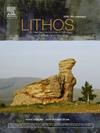厄瓜多尔西科迪勒拉山系和沿海前弧区基底构造史的新制约因素
IF 2.9
2区 地球科学
Q2 GEOCHEMISTRY & GEOPHYSICS
引用次数: 0
摘要
北安第斯山脉(南纬 5°以北)的西科迪勒拉山系和前弧是由大洋地壳覆盖的同生陆相构造而成的。厄瓜多尔西科迪勒拉山系和沿海地区超基性岩和基性岩基底序列缺乏准确的地质年代数据,导致已公布的构造模型存在明显差异,不同的同生单元以及增生和碰撞的时间线形成鲜明对比。我们展示了基底单元新的锆石 UPb 和地层 40Ar/39Ar 时间,并结合新的全岩地球化学和同位素数据,以确定它们在向南美洲增生之前和期间的构造历史。具有大洋高原亲缘关系的超基性岩和岩浆岩可分为两个高原序列,其中一个内侧、较年轻的高原(85-92 Ma;Pallatanga 块)与南美洲缝合,并被增生前的大洋内部弧(Pilatón-Pujilí 弧)所改变,该弧被增生过程所终止。一个更古老的外侧大洋高原序列(120Ma∼)构成了目前前弧内一系列海岸区块(皮尼翁区块、圣洛伦索区块、佩德纳莱斯区块,可能还有埃斯梅拉达斯区块)的基底。外侧高原上还有一个火山喷发前的洋内弧(帕斯瓜莱斯--圣洛伦索弧),在火山喷发期间和喷发后(圣洛伦索--里奥卡拉弧)仍很活跃。古地磁偏角的共时变化、早克里特大陆边缘开始快速掘起(>1 km/My)以及新形成的弧后前陆盆地和前陆区域内的沉积作用都支持这样一个模型,即在 75-70 Ma 的一次增生事件中,两个大洋高原序列都向南美洲增生。因此,吸积的大洋高原很可能是复合的,在吸积之前既包括较年轻的高原序列,也包括较古老的高原序列。我们测试了另一个模型,即内部(较年轻的)和外部(较老的)大洋高原依次增生,尽管这无法解释前弧区块旋转的时间。本文章由计算机程序翻译,如有差异,请以英文原文为准。
New constraints on the tectonic history of the basement of the Western Cordillera and coastal forearc of Ecuador
The Western Cordillera and forearc of the Northern Andes (north of 5° S) are constructed from allochthonous terranes floored by oceanic crust. A paucity of accurate geochronological data from the ultramafic and mafic basement sequences of the Western Cordillera and Coastal region of Ecuador has lead to distinct differences in published tectonic models, with different allochthonous units and contrasting timelines of accretion and collision. We present new zircon U![]() Pb and groundmass 40Ar/39Ar dates of the basement units, which have been combined with new whole rock geochemical and isotopic data to constrain their tectonic histories prior to and during their accretion to South America. Ultramafic and mafic rocks with oceanic plateau affinities can be divided into two plateau sequences, where an inboard, younger plateau (85–92 Ma; Pallatanga Block) is sutured against South America, and was modified by a pre-accretionary intra-oceanic arc (Pilatón-Pujilí arc) that was terminated by the accretionary process. An older, outboard oceanic plateau sequence (∼120 Ma) forms the basement to a series of coastal blocks within the present forearc (Piñon, San Lorenzo, Pedernales and probably the Esmeraldas blocks). The outer plateau also hosts a pre-accretionary intra-oceanic arc (Pascuales – San Lorenzo arc), which remained active during and post-accretion (San Lorenzo – Rio Cala arc). Coeval changes in palaeomagnetic declination, the onset of rapid exhumation (>1 km/My) of the Early Cretaecous continental margin and sedimentation within the newly formed retro-arc foreland basin and foreland region supports a model where both oceanic plateau sequences accreted to South America in a single accretion event at 75–70 Ma. Thus, it is likely that the accreted oceanic plateau was composite, and included both the younger and older plateau sequences prior to accretion. We test an alternative model where the inner (younger) and outer (older) oceanic plateaus accrete in sequence, although this fails to account for the timing of block rotations in the forearc.
Pb and groundmass 40Ar/39Ar dates of the basement units, which have been combined with new whole rock geochemical and isotopic data to constrain their tectonic histories prior to and during their accretion to South America. Ultramafic and mafic rocks with oceanic plateau affinities can be divided into two plateau sequences, where an inboard, younger plateau (85–92 Ma; Pallatanga Block) is sutured against South America, and was modified by a pre-accretionary intra-oceanic arc (Pilatón-Pujilí arc) that was terminated by the accretionary process. An older, outboard oceanic plateau sequence (∼120 Ma) forms the basement to a series of coastal blocks within the present forearc (Piñon, San Lorenzo, Pedernales and probably the Esmeraldas blocks). The outer plateau also hosts a pre-accretionary intra-oceanic arc (Pascuales – San Lorenzo arc), which remained active during and post-accretion (San Lorenzo – Rio Cala arc). Coeval changes in palaeomagnetic declination, the onset of rapid exhumation (>1 km/My) of the Early Cretaecous continental margin and sedimentation within the newly formed retro-arc foreland basin and foreland region supports a model where both oceanic plateau sequences accreted to South America in a single accretion event at 75–70 Ma. Thus, it is likely that the accreted oceanic plateau was composite, and included both the younger and older plateau sequences prior to accretion. We test an alternative model where the inner (younger) and outer (older) oceanic plateaus accrete in sequence, although this fails to account for the timing of block rotations in the forearc.
求助全文
通过发布文献求助,成功后即可免费获取论文全文。
去求助
来源期刊

Lithos
地学-地球化学与地球物理
CiteScore
6.80
自引率
11.40%
发文量
286
审稿时长
3.5 months
期刊介绍:
Lithos publishes original research papers on the petrology, geochemistry and petrogenesis of igneous and metamorphic rocks. Papers on mineralogy/mineral physics related to petrology and petrogenetic problems are also welcomed.
 求助内容:
求助内容: 应助结果提醒方式:
应助结果提醒方式:


